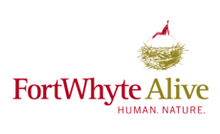FortWhyte Alive
 FortWhyte Alive! Logo | |
| Formation | 1983 |
|---|---|
| Type | Nature preserve |
| Headquarters | 1961 McCreary Rd. Winnipeg, Manitoba, Canada |
| Coordinates | 49°49′13″N 97°13′31″W / 49.8202°N 97.2252°W |
Region | Winnipeg Metro Region |
Official language | English |
President and CEO | Liz Wilson |
Vice-President | Ian Barnett |
| Website | fortwhyte |
Formerly called |
|

FortWhyte Alive is a reclaimed wildlife preserve, recreation area, and environmental education centre in southwest Winnipeg, Manitoba, Canada.
This 660-acre park is located along the migratory path of Canadian geese, and is named after the surrounding community of Fort Whyte.[1] As of 2022[update], it represents 20% of Winnipeg’s urban green space.[2]
History
[edit]The area that now encompasses the present-day space was given the name of Fort Whyte in 1888 by a top official of the Canadian Pacific Railway fought to take control of the site from a rival railway.[1]
Residents of Winnipeg used the area for picnicking and swimming. However, starting between 1907 and 1912, the Canada Cement Company (later known as Lafarge) fenced the area off and began mining the land for clay and gravel to make cement.[1]
By the 1950s, however, floods and other sources of clay made the site obsolete for mining.[1]
At this time, the principals of six schools in Greater Winnipeg sought to establish a nature trail for their students, and approached the director of the Winnipeg School Division’s Science Centre for his help in setting one up. The director referred them to the Chief of the Manitoba government’s conservation education section. After examining several potential sites, Fort Whyte was chosen due to its close proximity to Winnipeg, its relatively intact woodlands, protection from vandalism due to the site previously being privately-owned, and the presence of lakes (formed by the pits excavated for clay) that attracted water birds.[3]
In 1955, employees of Canada Cement formed the Lucky 13 Rod & Gun Club to develop a nature trail. The Fort Whyte Waterfowl Sanctuary opened in 1966 and introduce Canada geese and mallards to the site.[1][2][3]
The Province of Manitoba would incorporate the Wildlife Foundation of Manitoba that year to operate the facility and "provide facilities and financing for education in the science and art of conservation of wildlife and its habitat." The foundation saw the old industrial site as a potential habitat and began reclamation work here.[1]
In 1974, the Wildlife Foundation developed the site’s first building—the Fort Whyte Nature Centre—consisting of the Kiwanis Reception Building and a waterfowl building with an incubator room.[1][2]
By the 1980s, with its focus being shifted from wildlife conservation to environmental education, the organization was replaced by the Fort Whyte Foundation. The new foundation opened its new trail and Fort Whyte Centre for Environmental Education in 1983 at an expanded 200-acre site. Floating boardwalks were added the following year to provide a close-up view of the wetlands and their inhabitants. In 1986, the Kiwanis Touch Museum and beehive interpretive exhibits were added. An interpretive aquarium exhibit was added in 1989.[1]
In 2000, Fort Whyte's land base was expanded from 200 to 640 acres.[1]
Natural features
[edit]FortWhyte's 660 acres (270 ha) of prairie, lakes, forest and wetlands include a 70-acre (28 ha) bison prairie and related heritage exhibits;[4] more than 9 kilometres (5.6 miles) of interpretive nature trails; a family treehouse, floating boardwalks, and songbirds, deer and waterfowl in their natural habitat.
Activities and amenities
[edit]Year-round fishing is available or visitors can enjoy more contemplative pursuits such as canoeing, hiking or bird-watching.[5] Winter offers unique opportunities to enjoy ice fishing, snowshoeing, skating or tobogganing. FortWhyte's lakes, forest and marsh are well travelled, with over 100,000 visitors benefiting from many programs and exhibits annually.
The 6,700 sq ft (620 m2) Alloway Reception Centre offers a broad range of visitor services including The Nature Shop and Buffalo Stone Café.
The 10,000 sq ft (930 m2) Interpretive Centre features exhibits including the Aquarium of the Prairies (Manitoba's largest indoor aquarium), the Prairie Partners Room, the Touch Museum, the Climate Change Greenhouse and Prairie Soils dioramas among other exhibits relating to the environment and sustainable development.
Situated on a reclaimed clay mine and cement factory.
Education
[edit]FortWhyte offers curriculum-based educational programs in both French and English to close to 30,000 school children each year; introducing students to the natural world and raising an awareness of their role in sustaining our planet. The FortWhyte Farms[6] initiative allows disadvantaged youth to engage in urban agriculture-based, social and vocational skills training[7] in FortWhyte's beautiful natural setting.
References
[edit]- ^ a b c d e f g h i "Our Story". FortWhyte Alive. Retrieved 2023-07-16.
- ^ a b c "FortWhyte Alive's journey from clay quarry to urban green haven". sustainablebiz.ca. Retrieved 2023-07-16.
- ^ a b "Manitoba Organization: Wildlife Foundation of Manitoba / Fort Whyte Nature Centre / FortWhyte Alive". www.mhs.mb.ca. Retrieved 2023-07-16.
- ^ "EcoTours". FortWhyte Alive. Retrieved 2019-10-23.
- ^ "Manitoba's Pine To Prairie International Birding Trail" (PDF). Manitoba Conservation and Water Stewardship. May 7, 2013. Archived from the original (PDF) on February 13, 2019. Retrieved October 22, 2019.
- ^ "Youth build self-esteem at Fort Whyte Farms". Metro News. August 8, 2013. Archived from the original on December 2, 2013.
- ^ "Fort Whyte youth program gets $30K boost". CBC News Manitoba. July 13, 2010. Retrieved October 22, 2019.
Further reading
[edit]- Acorn, John, Alan Smith, and Nicola Koper. 2018. "Beaudry Provincial Park and FortWhyte Alive." Best Places to Bird in the Prairies. Greystone. ISBN 9781771643276
- Gordon, Patrick. 1967 September 16. "Nature: The teacher." Winnipeg Free Press. p. 70.
- MacDonald, Jake. 2009. The Fort Whyte Story: Human. Nature. Winnipeg: FortWhyte Alive. ISBN 978-0-9813732-0-1.
- "Wildlife bill moves." Winnipeg Free Press, 1966 March 26. p. 30.
